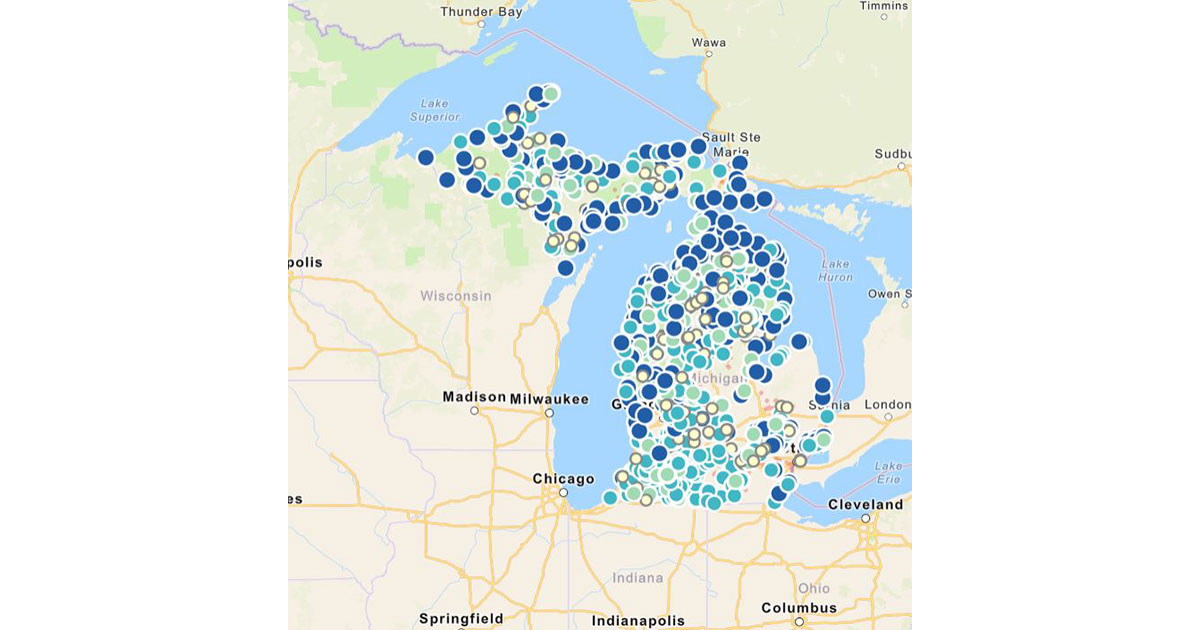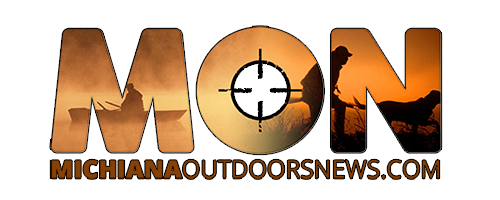- Details
MDNR Report

Heading out to fish? New sportfishing regulations for Michigan’s 2025 fishing season began Tuesday, April 1, and are in effect through March 31, 2026. Changes this season include modifications to steelhead and muskie size limits and gear restrictions on some waters. Highlights include:
Inland stream rainbow trout (steelhead) possession limit
Steelhead regulations on several Type 3 and Type 4 streams have been slightly modified from last year. Some streams no longer have a 20-inch minimum size limit on steelhead (the daily possession limit of which is one). See Pages 42-65 of the Michigan Fishing Regulations for more specific information.
New single-pointed hook restriction and spearing prohibition waters
The ports of Grand Haven, Muskegon and Whitehall/Montague have new single-pointed hook regulations Nov. 1-30, and spearing or possessing spearing gear is now prohibited in these waters Nov. 1-30. For more information, see Pages 16-17 and 30-31 of the Michigan Fishing Regulations.
Muskellunge size limit regulation
In Thornapple Lake (Barry and Eaton counties) and Lake Hudson (Lenawee County), new 50-inch minimum size limit regulations for muskellunge are in effect. These lakes are important sources of Great Lakes-strain muskellunge, from which the Michigan Department of Natural Resources is developing a population of mature adults for future stocking needs. Find more information on Page 13 of the Michigan Fishing Regulations.
Several other inland waters have undergone minor regulation changes focused on northern pike, bass and trout. Before you hit the water, make sure to review the 2025 Michigan Fishing Regulations thoroughly to learn any new laws that apply to your favorite fishing spots.
Don’t have your 2025 fishing license yet? Buy your fishing license online or through the Michigan DNR Hunt Fish app and visit Michigan.gov/Fishing for helpful resources including fishing location maps, fish ID information, the weekly fishing report and more.
- Details
MDNR Report

If you’re already dreaming of sun-soaked days on the water, take advantage of the DNR’s improved tool for navigating to your best boating destinations this summer.
The new Michigan Boating Facility Finder, or MiBFF, makes finding boating access sites a breeze. Use the interactive map to explore launch points, check watercraft rules and stay informed about closures.
You can find it at Michigan.gov/MiBFF.
“MiBFF provides updated facility information through a much-improved, user-friendly mapping system that cuts out the delays that the prior system had,” said Jordan Byelich, waterways development program manager for the DNR Parks and Recreation Division.
Here’s what you can expect when using MiBFF:
- More clearly identified launch-type information through map location points and a legend.
- Photos that clarify launch area information – especially helpful for first-time users of a boating access site!
- New search criteria to filter by launch type, body of water and presence of a boating pier and/or restrooms.
- Ability to print customized maps.
- Information about DNR-managed boating access site facilities as well as state-sponsored sites under local units of government.
Surrounded by one-fifth of the planet’s fresh surface water, it’s no surprise Michigan is home to great boating and fantastic freshwater recreation opportunities. With more than a thousand public boating access sites and 82 public harbors across the state, you'll find easy access to 3,300 miles of Great Lakes shoreline, 11,000 inland lakes and tens of thousands of miles of rivers and streams. Fun fact: Our state ranks second in the nation (behind Florida) for total watercraft registrations.
- Details
MDNR Report

Michigan Conservation Officers had a good week last week, helping two campers from falling temperatures and a man with heart trouble who capsized his boat.
Here are the details:
Camper rescue in Dead Stream Swamp
Two campers contacted the DNR Report All Poaching Hotline requesting rescue assistance after becoming stranded Friday in Dead Stream Swamp, a wetland consisting of more than 11,000 acres located between Cadillac and Houghton Lake in Missaukee and Roscommon counties.
The campers, whose names are not being released, were dropped off at the Dead Stream Swamp by a friend on Friday with the intent to camp for four days.
Rain developed during the evening hours and later turned to snow, soaking the campers and their gear. The temperature dropped to around 20 degrees Fahrenheit, which froze one of the men's inhalers and caused him to have difficulty breathing.
The campers contacted the RAP Hotline around 5 a.m. Saturday, saying they could not self-rescue.
Dispatchers contacted local conservation officers, Sgt. Brian Olsen and CO Ben McAteer, who immediately responded to the caller’s last known cellphone location – about 1 mile west of the intersection of Higgins Lake Road and Pine Road in Lyon Township.
It took officers about an hour to hike the 1 mile into the swamp, where they found the campers soaking wet in a makeshift shelter. The officers made a fire to help warm the campers and thaw their frozen boots. CO Matt Zultak also arrived on scene to assist.
Once the campers were able to put on their boots and pack their gear, it took the group another hour to make it out of the swamp. They were met along the way by CO James Garrett, who helped navigate to a location where EMS was waiting.
The group met EMS on Higgins Lake Road, south of Pine Road. EMS evaluated and released both campers at the scene.
Man and his dogs saved from AuSable
A 59-year-old man from Caro is expected to be released from the hospital after his boat capsized along the AuSable River in Alcona County.
Accompanied by his two dogs, the man, whose name is not being released, was fishing on a 10-foot boat when he fell into the river while trying to disembark. The water was only 39 degrees Fahrenheit, and air temperature was freezing at 32 degrees.
Using his watch, the man texted 911 that he’d fallen into the river and was having difficulty breathing. The DNR later learned that the man had open-heart surgery two years ago and had recently been feeling ill.
Alcona County Central Dispatch notified local emergency responders of the situation around 2:16 p.m.
DNR Conservation Officers Jeff Panich and Casey Pullum heard the radio communication. Based on the last known GPS coordinates from the man's watch, they responded to the intersection of Snowmobile Trail LP96 and the Shore to Shore Horse Trail at 3:12 p.m.
Panich and Pullum began walking the horse trail along the river and quickly located footprints in the snow. A short distance ahead, they saw a dog on the trail. Beyond the dog, they located the missing man, who was standing with blood covering his legs and feet. He was missing some clothes.
Panich immediately notified dispatch of the man’s location and requested assistance. After Panich approached the man, he said, “Help me,” and collapsed onto the conservation officer.
While the COs were waiting for medical assistance to arrive, the man became unresponsive. Panich and Pullum quickly pulled him out of the woods to a nearby river access parking lot, 4001 Bridge Landing, located off Federal Route 4001.
EMS and deputies quickly arrived and helped load the man into the ambulance, which transferred him to MyMichigan Medical Center Tawas.
Both dogs were secured and will be returned to the man when he is released from the hospital. The boat has not been recovered.
Alcona County Sheriff’s Department, Alcona County EMS and Curran Fire Department also assisted.
- Details
DNR Report
Saugatuck Brewing Company is reaffirming its commitment to supporting conservation and habitat restoration efforts across the state by once again partnering with the Michigan DNR.
Set to launch in April 2025, the Lake Street Light x Lake Sturgeon Program is a collaboration between SBC and the DNR designed to raise awareness and support the conservation of Michigan’s lake sturgeon population. A portion of proceeds from every Lake Street Light sold will be donated to DNR efforts aimed at restoring the lake sturgeon’s habitat and boosting its population.
The new light lager, Lake Street Light, is a crisp, refreshing brew with only 96 calories and 4% ABV, inspired by the beauty of Michigan’s lakes and waterways.
"Lake Street Light is more than just a beer—it's a nod to Michigan's wild heart,” said Sara Van Splinter, Director of Marketing at Saugatuck Brewing Company. “These shores, our 'Lake Street,' are home to countless species, and we’re proud to help protect one of them: the lake sturgeon, living fossils that have swum since the time of dinosaurs. This partnership with the Michigan DNR allows us to give back to the waters we love while sharing the story of these remarkable creatures."
Lake sturgeon are critical to Michigan’s aquatic ecosystems, but their population has declined due to habitat loss, pollution, and overfishing. The program’s proceeds will directly support the DNR’s sturgeon conservation projects.
- Details
MDNR Report

If you plan to take part in Michigan’s spring turkey season (April 19 through June 7) and you still need to take a hunter safety class, sign up soon. These classes are commonly offered ahead of the spring turkey season or in the fall before the start of firearm deer season.
To purchase a hunting license in Michigan, anyone born on or after Jan. 1, 1960, is required to successfully complete an approved hunter safety education course.
“We don’t want to see people wait until the week before they want to hunt to try locating a hunter safety class, at which point classes often are full,” said Lt. Tom Wanless, recreational safety, education and enforcement supervisor with the Michigan Department of Natural Resources.
There are four options for completing hunter safety education in Michigan, all of which require at least four hours of in-person instruction:
- Traditional classroom-based course.
- Online course followed by an in-person field day.
- Interactive online course (with animations and videos that put students in virtual real-life scenarios) followed by an in-person field day.
- Take-home study course followed by an in-person field day.
Wanless said the DNR-managed hunter safety education program helps the next generation of hunters learn how to safely, responsibly enjoy hunting and understand the importance of wildlife management and conservation.
“These classes build confidence and teach lifelong skills, such as firearm safety, wildlife and habitat management, and how to use a map and compass, to an average of 15,000 students every year,” Wanless said.
Once you successfully complete the hunter education course and receive your certificate, it is valid for life.
Learn more about the program and register for a class at Michigan.gov/HunterEducation.


